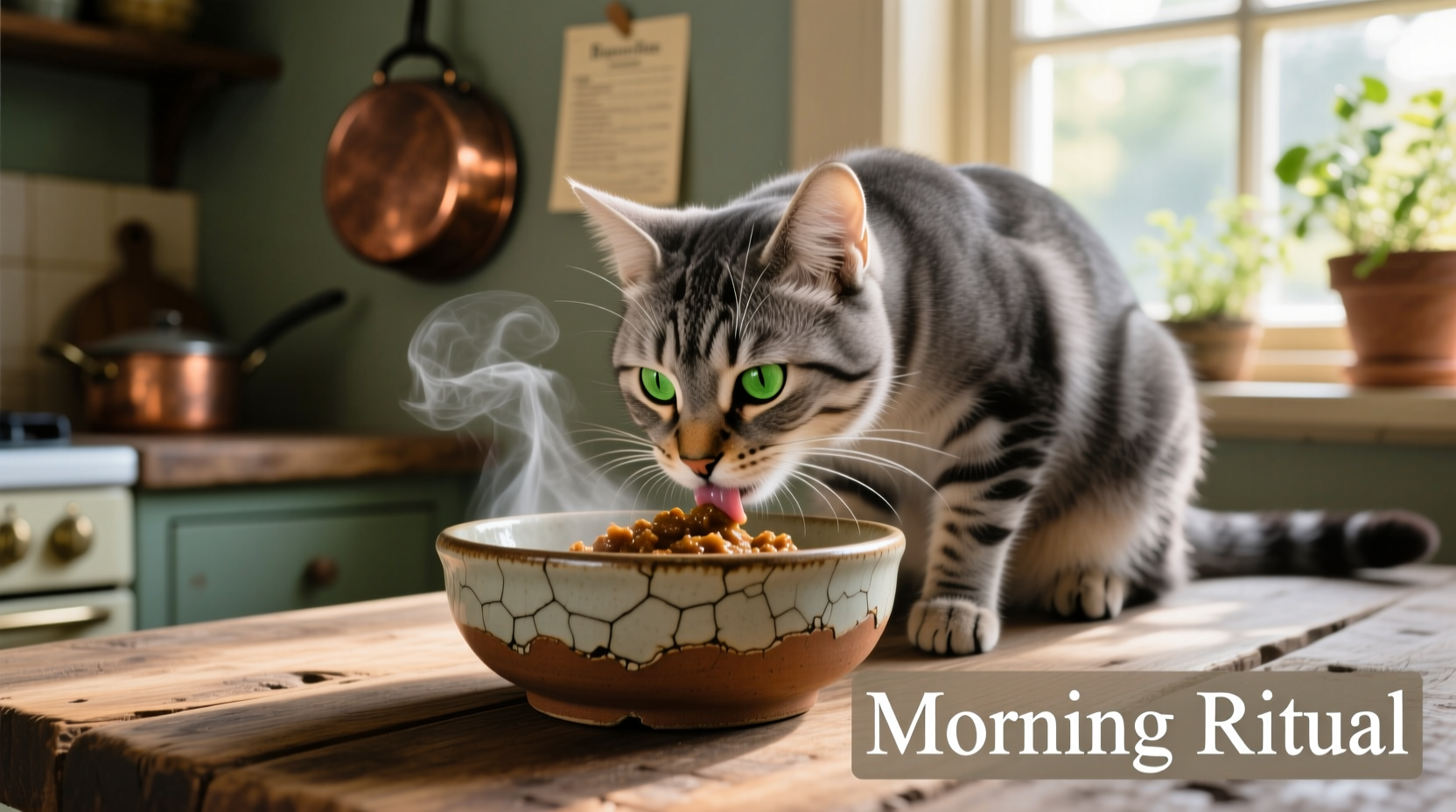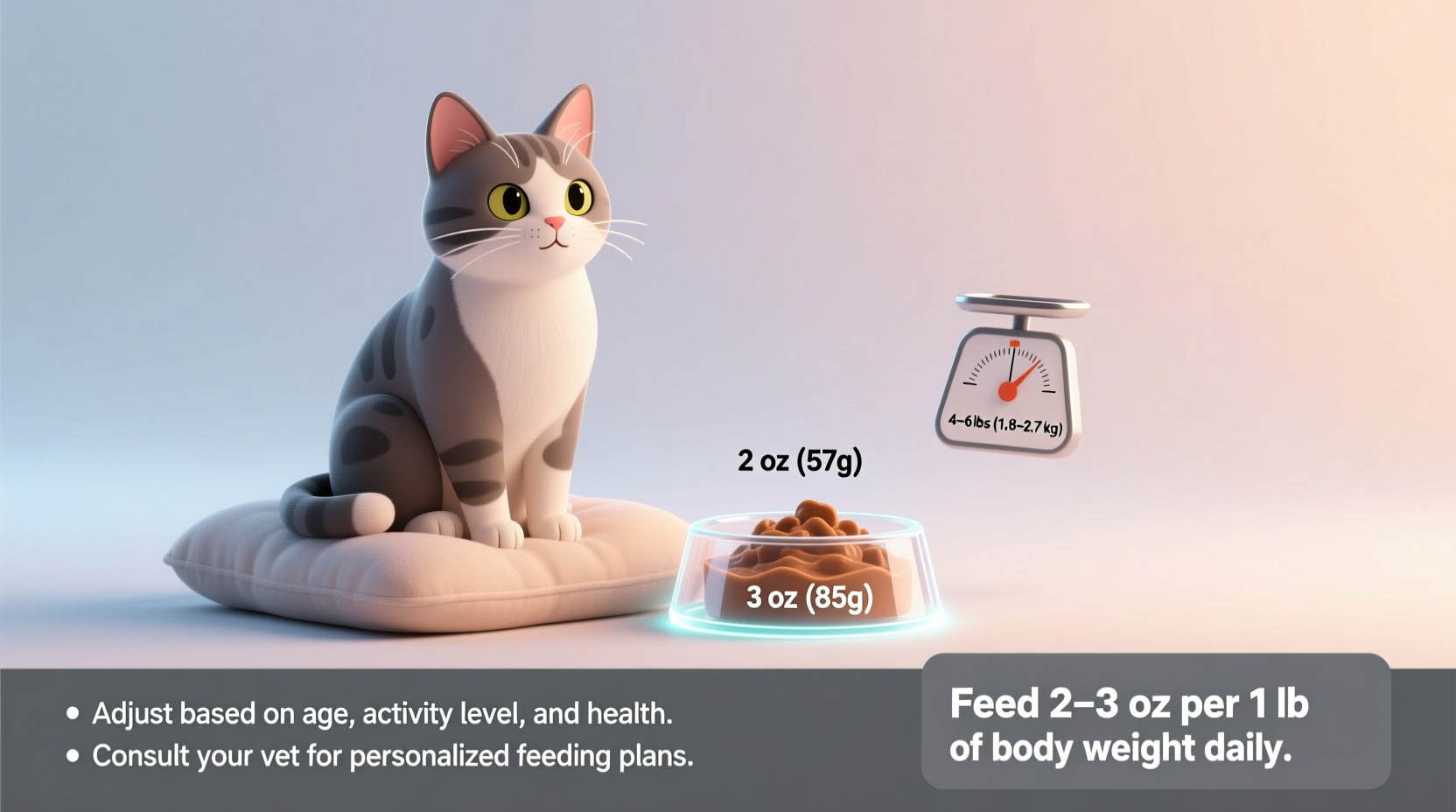Feed your adult cat 3-5 ounces of wet food per 5-8 pounds of body weight daily, divided into 2-3 meals. The exact amount depends on your cat's age, activity level, health status, and the specific food's calorie content. Always check the feeding guidelines on your cat food label and consult your veterinarian for personalized recommendations.
Getting the portion right matters more than you think. Overfeeding wet food can lead to obesity and related health issues, while underfeeding leaves your cat malnourished and dehydrated. With 60% of cats in the US overweight according to the Association for Pet Obesity Prevention, proper portion control is critical for your feline's long-term health.
Why Wet Food Measurement Requires Precision
Cats are obligate carnivores with specific nutritional needs that differ significantly from dogs or humans. Their bodies evolved to get most hydration from food rather than drinking water. Wet food typically contains 70-80% moisture compared to dry food's 10%, making proper portioning essential for both nutrition and hydration.
"Cats have a naturally low thirst drive," explains Dr. Sarah Wooten, DVM and veterinary expert. "When they don't get enough moisture from food, they become chronically dehydrated, which can lead to urinary tract issues and kidney disease."

Key Factors Determining Your Cat's Wet Food Needs
Before you measure that first spoonful, consider these four critical variables that affect how much wet food your cat requires:
1. Your Cat's Weight and Body Condition
Weight is the primary factor in determining food portions. However, not all cats of the same weight need identical portions. Body condition score (BCS) matters significantly:
| Body Condition | Visual Characteristics | Feeding Adjustment |
|---|---|---|
| Underweight (BCS 1-3) | Ribs visible, no fat cover, prominent bones | Increase by 10-15% of standard portion |
| Ideal (BCS 4-5) | Ribs palpable with light fat cover, waist visible | Follow standard portion guidelines |
| Overweight (BCS 6-9) | Ribs hard to feel, no waist, abdominal fat | Reduce by 10-20% of standard portion |
The World Small Animal Veterinary Association provides this standardized body condition scoring system used by veterinarians globally. Their visual guide helps owners accurately assess their cat's condition.
2. Life Stage Requirements
Cats' nutritional needs change dramatically throughout their lives:
- Kittens (up to 1 year): Need 2-3 times more calories per pound than adults. Feed 4-6 small meals daily of kitten-formulated wet food.
- Adults (1-7 years): Standard maintenance feeding as outlined in the initial recommendation.
- Seniors (7+ years): May need fewer calories but more protein. Consult your vet about senior-specific formulations.
3. Activity Level Considerations
Indoor cats typically need 20-30% fewer calories than outdoor or highly active cats. Monitor your cat's weight monthly and adjust portions accordingly. If your cat has recently become less active due to age or health issues, reduce portions proactively to prevent weight gain.
4. Food Calorie Density
Not all wet foods contain the same calories. Always check the label for kcal per ounce or per can. Most standard wet foods contain 25-35 calories per ounce, but therapeutic or high-protein formulas may contain more.
Practical Feeding Guidelines by Weight
Here's a general reference for daily wet food portions based on healthy adult cats:
| Cat Weight | Daily Wet Food Amount | Recommended Meals | Calorie Range (approx.) |
|---|---|---|---|
| 5-6 lbs | 3-3.5 oz | 2 meals of 1.5-1.75 oz | 75-105 kcal |
| 7-8 lbs | 4-4.5 oz | 2 meals of 2-2.25 oz | 100-135 kcal |
| 9-10 lbs | 5-5.5 oz | 2 meals of 2.5-2.75 oz | 125-165 kcal |
| 11-12 lbs | 6-6.5 oz | 2 meals of 3-3.25 oz | 150-195 kcal |
Note: These are general guidelines. Always prioritize the specific feeding instructions on your cat food packaging and your veterinarian's recommendations.
Avoiding Common Wet Food Feeding Mistakes
Many cat owners unintentionally compromise their pet's health through these common errors:
Leaving Food Out All Day
Wet food spoils quickly at room temperature. Bacteria can multiply to dangerous levels within 4 hours. Measure portions and remove uneaten food after 30-60 minutes for adult cats, or 15-20 minutes for kittens.
Free-Feeding Wet Food
Unlike dry food, wet food shouldn't be left out for free-feeding. This practice leads to overeating, food spoilage, and dental issues. Measure precise portions and feed at scheduled times.
Ignoring Individual Health Conditions
Cats with diabetes, kidney disease, or urinary issues may require specialized feeding protocols. The American Association of Feline Practitioners notes that 30% of cats develop kidney disease by age 10, often requiring modified protein and phosphorus levels in their diet.
Transitioning Between Food Types
If switching from dry to wet food or changing brands, do so gradually over 7-10 days:
- Days 1-2: 25% new food, 75% current food
- Days 3-4: 50% new food, 50% current food
- Days 5-7: 75% new food, 25% current food
- Days 8-10: 100% new food
This gradual transition prevents digestive upset and gives your cat time to adjust to the new texture and flavor. If your cat refuses the new food, try warming it slightly or adding a small amount of tuna juice (not packed in oil) to enhance the aroma.
When to Consult Your Veterinarian
While general guidelines are helpful, your veterinarian provides the most accurate feeding recommendations for your individual cat. Schedule a consultation if:
- Your cat gains or loses more than 10% of body weight in a month
- You notice changes in drinking or urination habits
- Your cat consistently leaves food or seems hungry after meals
- You're adopting a senior cat or one with known health issues
Regular veterinary checkups (at least annually for healthy adults) should include body condition assessment and dietary consultation. The Cornell Feline Health Center emphasizes that obesity is the most common nutritional disorder in cats, affecting nearly 60% of the feline population and reducing lifespan by up to 2.8 years.
Monitoring Your Cat's Response to Feeding Changes
After adjusting portions, monitor these key indicators for 2-4 weeks:
- Weight changes: Weigh monthly using the same scale
- Coat condition: Healthy cats have shiny, smooth fur
- Energy levels: Should be active but not hyper
- Litter box habits: Consistent, well-formed stools
- Hydration: Skin should snap back quickly when gently pinched
Keep a simple log of your cat's weight and any observations. This information proves invaluable during veterinary visits and helps you identify trends before they become serious issues.
Final Thoughts on Cat Wet Food Portioning
Feeding the right amount of wet food requires attention to your cat's individual needs rather than following a one-size-fits-all approach. By understanding the factors that influence portion sizes and monitoring your cat's response, you'll provide optimal nutrition while preventing common health issues associated with improper feeding.
Remember that your cat's nutritional needs may change with age, health status, and lifestyle. Regular veterinary consultations combined with careful observation of your cat's body condition will help you maintain the perfect balance for a long, healthy life.











 浙公网安备
33010002000092号
浙公网安备
33010002000092号 浙B2-20120091-4
浙B2-20120091-4